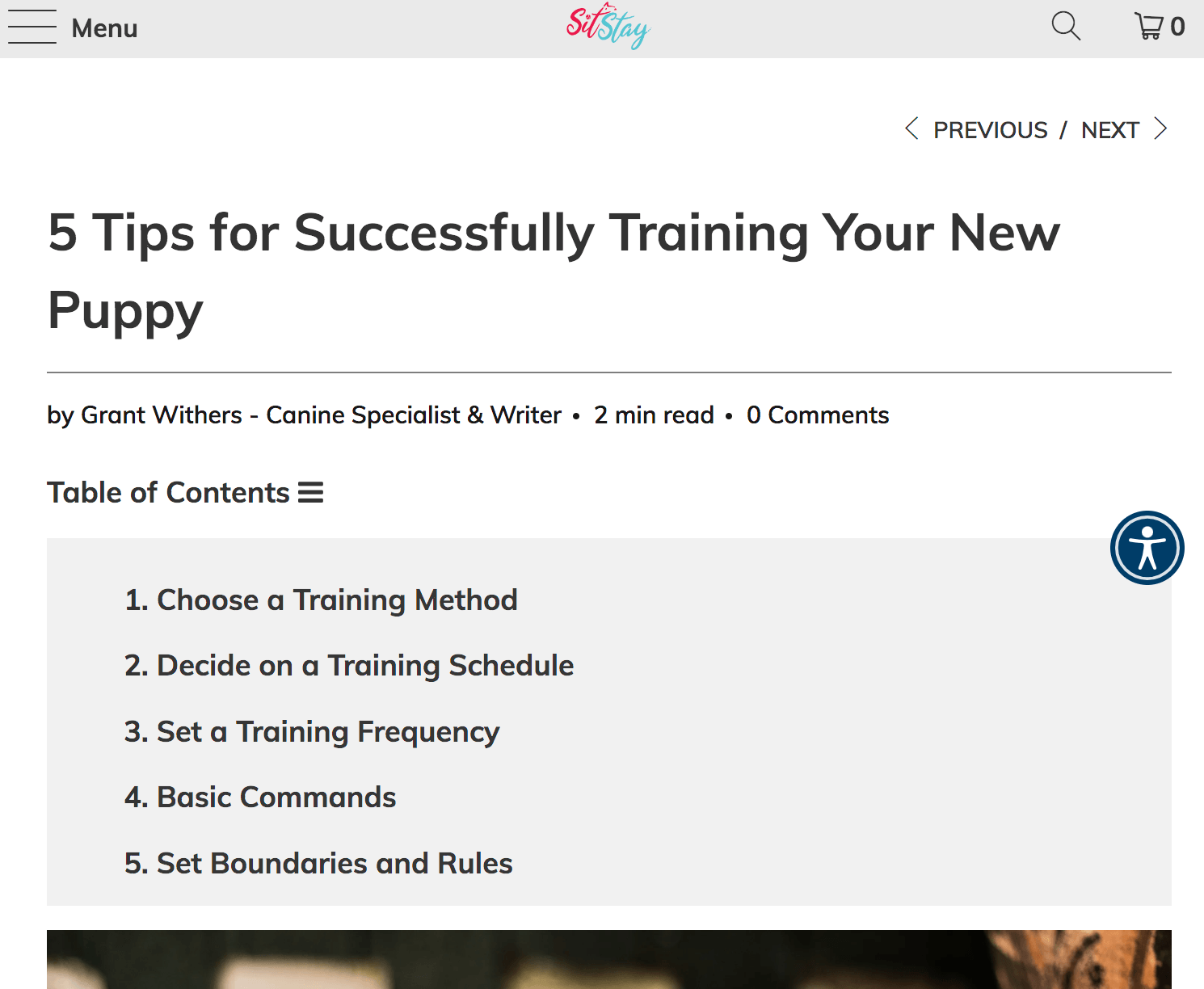-
 Published: Aug 1, 2023
Published: Aug 1, 2023
-
 8 min. read
8 min. read
-
 Macy Storm
Macy Storm Senior Content Creator
Senior Content Creator
- Macy is a marketing writer with over five years of experience creating content for dozens of industries including food and beverage, home services, and education. She also specializes in creating SEO and PPC content. Her work has been featured by Search Engine Journal, HubSpot, Entrepreneur, Clutch, and more. In her free time, Macy enjoys trying new crafts and reading comic books.
Search engine optimization (SEO) is a crucial component for helping you drive success online. With over 1 billion people using Google every month, you must optimize your SEO strategy to maximize your results.
That’s where SEO workflows can help.
SEO workflows enable you to break down SEO tasks into smaller steps to ensure you’re completing each SEO task efficiently and effectively.
Keep reading to learn:
If you want to get more tips and tricks on how to improve your SEO strategy, subscribe to our email newsletter!
Don’t miss our Marketing Manager Insider emails!
Join 200,000 smart marketers and get the month’s hottest marketing news and insights delivered straight to your inbox!
Enter your email below:
Inline Subscription Form – CTA 72
“*” indicates required fields
(Don’t worry, we’ll never share your information!)

What is an SEO workflow?
An SEO workflow is a map of the steps you need to take to complete a task related to search engine optimization. It involves breaking down larger SEO tasks into small and manageable steps to help you optimize your SEO process.
Why create an SEO workflow process?
When it comes to doing SEO efficiently and effectively, SEO workflow management is key. There are numerous reasons to create a workflow process for your search engine marketing strategy.
First, creating an SEO workflow process ensures you don’t miss any valuable steps for whatever task you’re completing. If you’re creating content, for example, you don’t want to forget to identify keywords for your piece or to integrate visuals.
A workflow ensures you touch upon every crucial step for a particular SEO task.
Additionally, workflow SEO enables you to complete tasks more efficiently. Instead of continually asking, “Did I do everything?” and checking your work ten times over, you have a process that ensures you don’t miss a step. SEO workflows enable you to spend less time worrying and more time focusing on completing valuable tasks.
5 types of SEO workflows you can create
Now that you know the value of SEO workflow management, let’s dive into some workflows you can create to help improve your SEO process.
Here are five types of SEO workflows you can create:
SEO workflow #1: Conducting keyword research
First on this list for workflow SEO, let’s look at conducting keyword research. Keyword research is a crucial component of SEO because it determines which results your web pages appear in and, subsequently, who sees them.
Creating a keyword research workflow will help you through the process of finding, identifying, and using relevant keywords.

So, what might this SEO workflow process look like?
- Identify broad main terms related to your industry
- Create a list of more specific keywords related to broad keyword
- Use a keyword research tool to find data about those terms (search volume, for example) and additional related key terms
- Map out how to use the new keywords (blog post, informational article, etc.)
- Execute your content plan
This list above is an example of how a keyword research workflow may look. Your workflow will differ based on your business’s needs and what you focus on when doing keyword research. For example, you may have a step where you create a keyword map to help identify and connect terms.
Overall, creating an SEO workflow for keyword research is a great way to ensure you know the steps for identifying and using keywords for your website.
SEO workflow #2: Creating content
Another SEO workflow you can create is one for creating content. Content creation is a critical component of a successful SEO strategy –– your content is what ranks in search results and drives traffic to your business.
With a content creation workflow, you may opt to break it down into multiple workflows or have numerous steps within each step for completing tasks.
For example, you might break down your process into steps for creating , editing, and then publishing content. You would create a separate SEO workflow for each component.
If you want to keep everything in one big workflow, it might look like this:
- Identify your content topic
- Identify keywords to target within your content
- Research to identify important information
- Outline your content piece
- Write the content piece
- Integrate elements like links, photos, and videos within your content
- Send content to the editor
- Review revisions and suggestions and make changes
- Send content back to the editor for a final edit
- Publish content on the website

This example is a simplified version of a content process that you might break down into smaller sub-steps or, as mentioned above, break into separate SEO workflows.
Creating a workflow for content creation is critical for ensuring that you don’t miss any steps when sharing information with your audience. It will ensure you have a seamless content creation process from idea to published blog post.
SEO workflow #3: Optimizing existing content
When creating your SEO workflow process, keep in mind that creating content isn’t the only type of workflow you want to have in place. You also want to have a workflow for optimizing existing content.
As you continuously create content, things in your industry change. Information becomes outdated, statistics are old, or processes are no longer relevant. It’s crucial to keep your content fresh and updated to ensure you provide the most accurate information to your audience.
So, how might your workflow look for optimizing existing content?
Here’s an example of an SEO workflow for re-optimizing content:
- Identify content that needs re-optimization
- Identify why the content needs updating
- Identify whether the content needs some tweaks or a full re-write
- Make the necessary changes and updates to your content
- Publish your content
This is a simplified process for how to create a content re-optimization workflow. You might find that, for your business, you want to create two separate workflows for content that just needs a few updates versus content that needs a complete overhaul.
By creating a content re-optimization workflow, you’ll ensure you have a smooth process for improving content on your website.
SEO workflow #4: Auditing your website
Another part of SEO workflow management is creating a workflow for auditing your website. Auditing your website is crucial for understanding what’s working on your website and what you need to fix to drive better results with your SEO strategy.
Generally, many people will use an auditing tool to help them simplify the process. Here’s an SEO workflow showing the use of an auditing tool:
- Identify the pages you want to audit
- Use your SEO auditing tool to analyze the pages
- Analyze the results of your strengths, weaknesses, and opportunities
- Identify the issues impacting your SEO
- Follow the recommended changes to improve your page
- Repeat the process for each audited page
Having a workflow in place for auditing your SEO strategy is crucial to ensure you’re optimizing your website for success and maximizing your results.
SEO workflow #5: Building links
The last SEO workflow we’ll cover is building links.
Linking is a critical component of SEO that helps you rank better in search results. Backlinks help you boost credibility and drive traffic to your website, while internal links help Google crawl and index your pages. That’s why it’s important to use workflow SEO to optimize your link building process.
Similar to other SEO workflows, you may want to break down link building into two separate workflows –– internal linking and backlinks.
An example of a simplified link building workflow looks like this:
- Identify places within your new content where you can place internal links
- Publish new content
- Take new content URL and find places on other pages to integrate URL
- Identify external pages where you can earn a new link (blogs, industry websites, etc.)
- Conduct an audit of linking strategy
- Make changes and optimize as necessary

By creating a workflow process for your linking strategy, you’ll help ensure your links help you improve your SEO.
Need help creating the right SEO workflow?
To keep your SEO strategy on track, you need to create SEO workflows. These workflows will ensure that all aspects of your SEO strategy run smoothly to help you maximize your SEO strategy.
If you need help managing your SEO workflow, WebFX can help. We have a team of over 500 SEO experts that know how to drive success with SEO. We’ve driven over $6 billion in revenue for our clients in the past five years alone.
We also have locations all around the world, so whether you’re in need of Baltimore SEO services, Ft. Myers SEO services, or solutions in any other city, we’ve got you covered.
We build custom SEO plans to meet your business’s needs and ensure that all your SEO workflows are optimized to drive the results you desire.
Ready to get an SEO plan built to help your business succeed? Contact us online or call us today at 888-601-5359 to speak with a strategist!
-
 Macy is a marketing writer with over five years of experience creating content for dozens of industries including food and beverage, home services, and education. She also specializes in creating SEO and PPC content. Her work has been featured by Search Engine Journal, HubSpot, Entrepreneur, Clutch, and more. In her free time, Macy enjoys trying new crafts and reading comic books.
Macy is a marketing writer with over five years of experience creating content for dozens of industries including food and beverage, home services, and education. She also specializes in creating SEO and PPC content. Her work has been featured by Search Engine Journal, HubSpot, Entrepreneur, Clutch, and more. In her free time, Macy enjoys trying new crafts and reading comic books. -

WebFX is a full-service marketing agency with 1,100+ client reviews and a 4.9-star rating on Clutch! Find out how our expert team and revenue-accelerating tech can drive results for you! Learn more
Try our free SEO Checker
Boost your site’s search performance with our free SEO Checker. Analyze your website for optimization tips on titles, headers, content, speed, and more. Get a free report now to enhance rankings on Google, Bing, Yahoo, and beyond!



How Is Your Website’s SEO?
Use our free tool to get your score calculated in under 60 seconds.
Try our free SEO Checker
Boost your site’s search performance with our free SEO Checker. Analyze your website for optimization tips on titles, headers, content, speed, and more. Get a free report now to enhance rankings on Google, Bing, Yahoo, and beyond!






